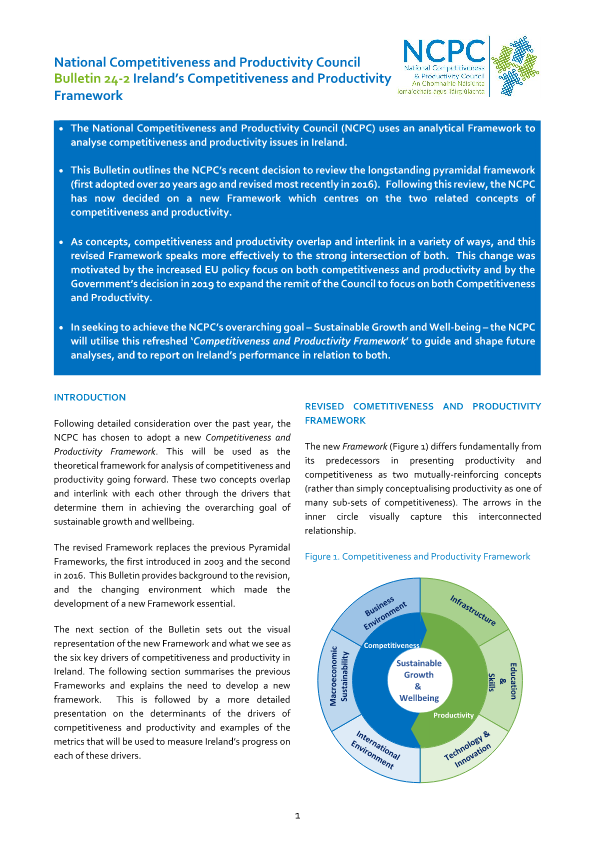- Bulletin 25-5: Benchmarking the Performance of Ireland’s Public Administration, 2024
- NCPC Welcomes Publication of Accelerating Infrastructure Report and Action Plan
- Budget 2026 and Competitiveness: Navigating Uncertainty
- NCPC Welcomes Government's Action Plan on Competitiveness and Productivity
- Call for Expressions of Interest - Member of the National Competitiveness and Productivity Council
- Bulletin 25-4: IMD World Competitiveness Rankings
- Ireland's Competitiveness Challenge 2025
- The Chair presents to the second annual Competitiveness Summit of Ministers hosted by the Taoiseach
- Bulletin 25-3: The Competitiveness Implications of Post-Pandemic Learning Losses
- Bulletin 25-2: Re-estimating Ireland’s International Competitiveness Performance
- Retrospective Review, 2020-2023
- NCPC's South-East Regional Seminar
- Bulletin 25-1: Developments in Ireland's National Productivity Statistics
- The Government Response to Ireland’s Competitiveness Challenge 2024
- Budget 2025 and Competitiveness: Investing in Ireland’s Future Prosperity
- NCPC Chair attends the Competitiveness Summit
- Ireland's Competitiveness Challenge 2024
- Bulletin 24-4 IMD World Competitiveness Rankings
- Bulletin 24-3 Competitiveness and the Housing Market in Ireland
- NCPC's Mid-West Regional Seminar
- NCPC Welcomes DETE-ESRI Joint Economic Research Programme Seminar
- Bulletin 24-2 Ireland’s Competitiveness and Productivity Framework
- ESRI Publish Working Paper of DETE ESRI Joint Research Programme
- Bulletin 24-1 Re-estimating Ireland’s International Innovation Performance
Bulletin 24-2 Ireland’s Competitiveness and Productivity Framework
Ireland’s Competitiveness and Productivity Framework bulletin outlines the National Competitiveness and Productivity Council’s (NCPC) recent decision to review the longstanding pyramidal framework. The revised framework replaces the previous pyramidal frameworks, the first introduced in 2003 and the second in 2016. This Bulletin provides background to the revision, and the changing environment which made the development of a new framework essential.
As concepts, competitiveness and productivity overlap and interlink in a variety of ways, and this revised framework speaks more effectively to the strong intersection of both. This change was motivated by the increased EU policy focus on both competitiveness and productivity and by the Government’s decision in 2019 to expand the remit of the Council to focus on both Competitiveness and Productivity.
The new framework differs fundamentally from its predecessors in presenting productivity and competitiveness as two mutually-reinforcing concepts (rather than simply conceptualising productivity as one of many sub-sets of competitiveness). The arrows in the inner circle visually capture this interconnected relationship. These two concepts overlap and interlink with each other through the drivers that determine them in achieving the overarching goal of sustainable growth and wellbeing. The main drivers included in the revised framework are Business Environment, Macroeconomic Sustainability, International Environment, Technology and Innovation, Education and Skills, and Infrastructure.

